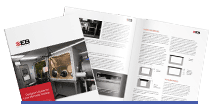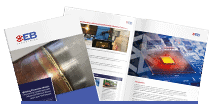The aerospace industry demands high-precision, high-strength welds that can withstand extreme stresses, harsh environments and strict safety standards. Several advanced welding methods are used in aerospace manufacturing, each chosen based on specific requirements like material type, joint complexity and performance demands. Here, we explore the main types of welding in aerospace applications and the benefits each one brings.
 |
GuideDesigners Guide for Laser Hermetic Sealing White Paper |
- Electron Beam Welding (EBW)
Electron Beam Welding is a go-to technique for many aerospace applications, particularly when dealing with challenging materials, complex geometries and high-strength requirements. Here’s why EBW stands out in aerospace:
-
Deep Penetration and High Strength: EBW can create very deep, narrow welds that deliver excellent strength, making it suitable for critical aerospace components such as engine parts, turbine blades and structural elements. This deep penetration capability is achieved without needing multiple weld passes, which reduces the risk of defects.
-
Precise Control in a Vacuum Environment: EBW is performed in a vacuum, preventing exposure to oxygen and other contaminants that could compromise the weld. This is crucial when welding reactive metals like titanium, often used in aerospace for its strength-to-weight ratio.
-
Welding Dissimilar Metals: Aerospace assemblies often involve dissimilar metals (such as titanium and stainless steel), which can be challenging to weld using conventional methods. EBW’s high-energy beam enables precise control over the welding zone, making it easier to weld these materials without cracking or other issues.

White Paper
Welding Dissimilar Metals: Overcoming Challenges with Advanced Electron Beam and Laser Techniques
Due to these strengths, Electron Beam Welding is a preferred choice for components where structural integrity and material compatibility are paramount.
-
- Laser Beam Welding (LBW)
Laser Beam Welding is another advanced technique widely used in aerospace manufacturing. While it shares some characteristics with EBW, LBW has its own unique advantages:
-
High-Speed Welding for Volume Production: LBW is significantly faster than EBW, making it ideal for high-volume production. Aerospace parts that have less stringent depth requirements and where speed is a priority, such as certain fuselage components and thinner assemblies, often benefit from laser welding.
-
Lower Operational Costs: Unlike EBW, LBW does not require a vacuum chamber, which reduces equipment and operational costs. The lack of a vacuum requirement also simplifies the setup, making LBW an efficient choice for components with simpler specifications.
-
Precision and Flexibility: LBW produces a focused beam that allows for highly precise welds, making it useful for parts with intricate details or small, delicate joints. Its ability to be automated and adapted to complex geometries also increases its value in aerospace applications where precision is vital but high-strength welds are not as critical as in EBW.
Laser welding is therefore preferred for speed-sensitive production and applications where the welding depth and environmental controls required by EBW are less critical.
-
- Tungsten Inert Gas (TIG) Welding
Tungsten Inert Gas (TIG) welding, also known as Gas Tungsten Arc Welding (GTAW), is commonly used in aerospace for structural components and joints that are challenging to access. Although it doesn’t provide the precision, lower heat input or speed of EBW and LBW, TIG welding offers several advantages:
-
Suitability for Complex Joint Configurations: Aerospace components often have intricate designs and hard-to-reach joints. TIG welding’s adaptability allows welders to navigate complex angles, ensuring that the weld is accurate and stable even in these tight spaces.
-
Versatile Material Compatibility: TIG welding can be used on a wide range of metals, including aluminum, stainless steel, and magnesium alloys, which are commonly used in aerospace. This versatility makes it ideal for structural assemblies, landing gear components, and other parts that require a balance of strength and flexibility.
While TIG welding is typically slower and produces more heat than EBW and LBW, it remains an essential method for areas that require a high degree of control and accessibility.
-
Choosing the Right Welding Technique
The choice of welding technique in aerospace applications depends on various factors, including:
-
Material Type: Different metals and alloys respond differently to heat, pressure, and environmental conditions. EBW and LBW are excellent for reactive or high-strength metals, while TIG is often used for more ductile materials.
-
Component Complexity: Components with complex geometries or hard-to-reach joints may benefit from TIG welding, while parts with straightforward weld paths suited to automation may be better suited to EBW or LBW.
-
Strength and Depth Requirements: When deep, high-strength welds are necessary, EBW is generally preferred. For less depth but high precision, LBW provides a fast, cost-effective solution.
-
Production Speed and Cost: In applications where speed and lower costs are prioritized, LBW often outperforms EBW due to its non-vacuum setup and rapid welding capabilities.
Each welding method offers unique advantages tailored to specific aerospace needs. By choosing the appropriate welding technique, aerospace manufacturers can meet stringent safety, reliability, and performance standards – essential for the demanding conditions encountered in flight and space exploration.

